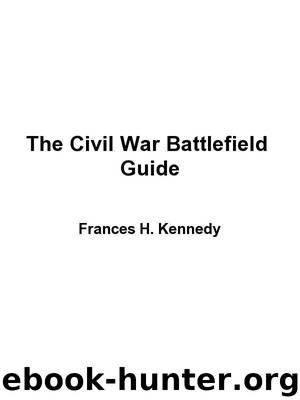The Civil War Battlefield Guide by Frances H. Kennedy

Author:Frances H. Kennedy
Language: eng
Format: azw3, epub
Publisher: HMH Books
Published: 1998-11-01T16:00:00+00:00
CS Brigadier General Carnot Posey's Mississippians and CS Brigadier General Edward A. Perry's Floridians swarmed across the tracks and enveloped US Colonel Thomas Smyth's left flank. US Captain Nelson Ames's artillery roared into action and forced Perry and Posey back. When Cooke and Kirkland retreated, they left CS Major David G. Mcintosh's artillery battery without infantry protection. Union soldiers rushed forward, captured five guns, and pulled them back to the south side of the tracks.
By 4:00 P.M. the Confederate battle lines had reformed about five hundred yards north of the railroad, and Ewell's corps and Lee had arrived. Union and Confederate artillery units began dueling, with the Union artillery having the advantage of stronger positions. At about 5:00 P.M. CS Major General Robert E. Rodes's Division of Ewell's Corps seized the Kettle Run railroad bridge one mile west of Bristoe. Darkness approached, and the battle of Bristoe Station was over.
Sporadic artillery fire continued during the evening. Confederate soldiers remained at their battle stations on the field, and it began raining. Throughout the night, the men listened to the cries of their wounded who lay near the railroad embankment and the Union line. The Federals carried their wounded off the battlefield, and by midnight they had quietly waded across Broad Run and resumed their march to Centreville.
Early the next morning Lee and Hill rode across the battlefield. Lee was displeased. He told Hill to "bury these poor men and let us say no more about it." Upon reading the battle reports, Jefferson Davis concluded, "There was a want of vigilance." Hill's misreading of the Federals' troop and position strength, his failure to determine the proximity of Confederate reinforcements, and his impatience, combined with Warren's patience and effective use of the battlefield terrain—including the railroad embankment—resulted in the Confederate defeat. They lost about 1,380 men, and the Federals, about 540. The North Carolina brigades suffered the most. Cooke's casualties were 700, and Kirkland's 602.
Download
The Civil War Battlefield Guide by Frances H. Kennedy.epub
This site does not store any files on its server. We only index and link to content provided by other sites. Please contact the content providers to delete copyright contents if any and email us, we'll remove relevant links or contents immediately.
4 - Harry Potter and the Goblet of Fire by J.K. Rowling(2657)
2010-The City & the City by China Miéville(1945)
Wall and Piece by Banksy(1781)
Thank You for Being Late by Thomas L. Friedman(1739)
The Old Farmer's Almanac 2020 by Old Farmer’s Almanac(1661)
The Mirror and the Light by Hilary Mantel(1634)
Journey to the Abyss by Harry Kessler(1602)
The Andy Warhol Diaries by Andy Warhol(1565)
Tolkien, J. R. R. - The Fellowship of the Ring by Tolkien J. R. R(1496)
Life on Earth by David Attenborough(1433)
Art Nouveau by Carol Belanger Grafton(1397)
The Museum Of Innocence by Orhan Pamuk(1380)
Harry Potter - A History of Magic by British Library(1372)
The Business of Being an Artist by Daniel Grant(1339)
Frida by Hayden Herrera(1281)
The Future Is Japanese by(1271)
Impeach by Neal Katyal(1248)
A History of Japanese Art by Noritake Tsuda(1200)
1215 by Danny Danziger(1163)
